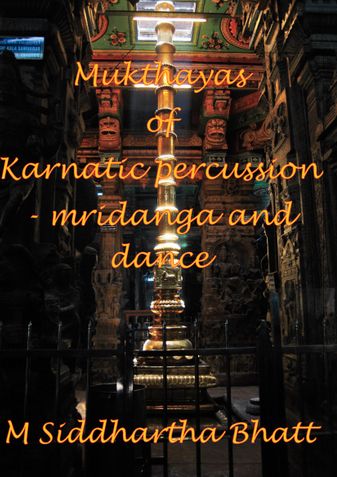You can access the distribution details by navigating to My pre-printed books > Distribution
Mukthayas of Karnatic percussion-mridanga and dance (eBook)
Mukthayas for Karnatic mridangam
Description
This book (around 660 pages) focusses on the important topic of mukthayas (terminations of sequences, stanzas and sections) also called as Korvais in Karnatic percussion. Mukthayas are triplet structure assembled out of either a theka or a faran. Mukthayas can be classified in several ways such as:
Based on application:
Upa (minor) Mukthayas: They are normally developed to a fraction of an avartana or an avartana and in extreme cases over an avartana. These serve to terminate sub-sections, sections in songs and instrumental rendering.
Pradhana (major) Mukthayas: These run into several avartanas and serve to terminate sections in solo rendering. These are generally designed on the structure of a leading portion (poorvanga), mid portion (madhyanaga) and a terminal portion (uttaranga) and rendered in triguna prayoga (three runs).
Based on the operational context:
Theka based Mukthayas: Here, the preceding theka sequences are continued or lingered on to maintain the same mood and gradually the Mukthayas are commenced.
Faran based Mukthayas: Here the same preceding farans or urutals are used as the constructional element for building up of the mukthaya.
Based on fitting into an avartana of a tala of a given nadai:
Exactly fitting (Shudha jodike) mukthayas: This is when the mukthaya exactly fits into the avartana of the tala under rendition as an integral multiple of the avartana.
Inexactly fitting (ashudha jodike) Mukthayas: This is when the mukthaya of one tala in a given nadai is proposed for rendering in another tala which is numerically different in no. of aksharas. Also, a large number of Mukthayas of great symmetry can be configured from the theka and faran strings and sequences but unfortunately these do not exactly fit into any tala for any given nadai. Not deterred by any such fitting issues, Karnatic percussionists crave to handle them by bala bandhana (marshalling into right aligning) these to the tala under rendering.
The first Chapter of the book gives an introduction to Karnatic percussion and the second chapter covers the all important topic of tala (musical meter). The third Chapter brings out the building blocks of mridanga vocabulary from raw sounds. The next three chapters are devoted to mukthayas- Chapter 4 covers basic architecture and principles (tatvas) of mukthayas including marshalling and visama alignment, Chapter 5 show cases the formulation of upa mukthayas and Chapter 6 is devoted to pradhana mukthayas. Both matra karana and amatra karana (metric and ametric sequencing) applicable to stira kalamsa and astira kalamsa (isochronous and non-isochronous beats) and under graha or nadana karana (syncopated operational meter) are brought out. Chapter 7 brings out some simple pradhana mukthayas including pancha nadai mukthayas in the Adi tala. A glossary of vernacular terms and pronunciations in Devanagari is given in Chapter 8.
The book contains around 70 illustrations and 170 tables and numerous equations for computation of the mukthaya sizes. Around 1800 combinations of poorvangas (frontal sections) and 250 combinations of uttarangas (posterior sections) of mukthayas are described for marshalling of akanda (composite) mukthayas. Typical theka and faran based mukthayas are illustrated for the five popular talas.
About the Author
Book Details
Ratings & Reviews
Other Books in Music
Dr. Rahul Bhore
REEBA THOMAS
Jyrah Ludie John
Riddhi Sanyal





Re: Mukthayas of Karnatic percussion-mridanga and dance (eBook)
This is a very good book on korvais or mukthayams used in Karnatic percussion. The author has segregated them into simple and straight forward mukthayams called as upam mukthayams and the more complex ones called as pradhanam mukthayams. The author has dissected the structure of these sequences precisely and brought out thousands of combinations of the mukthayams of a large number of varieties. They are useful to both the musicians for use in their swara patterns as well as for the percussionists who can use them in normal rendering, pallavi rendering and in tani avartanams. The book which is in fact a monograph on mukthayams is well written and it has good clarity. I have great pleasure in recommending it both the musical community as well as the upcoming percussionists who can incorporate many of these in their rendering.